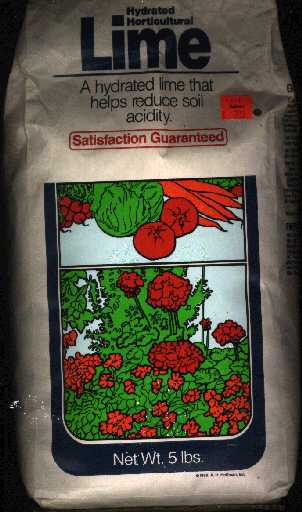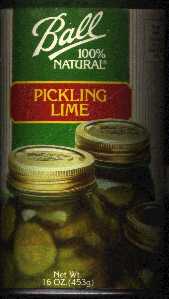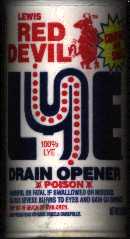Lime is a very important chemical which is of central importance to many industries including several that we will discuss in these pages. We will use it initially to produce lye for making soap. Later we will use it to make glass. Lime is also widely used in agriculture, water treatment, paper manufacture, and in mixing cement and concrete. Unlike many other chemicals whose manufacturing technology has changed over time, lime is manufactured today by essentially the same process as was used in antiquity. Calcium appears in the second column of the periodic table, the alkaline earths, along with magnesium and barium.
U.S. Production of lime was 15 billion kg in 1989 making it the 6th most-produced chemical in the U.S.
One problem with lime, however, is that it is not very soluble in water. When lime and soda ash combine in a classic metathesis reaction, they produce lye, or sodium hydroxide. Lye combines the solubility of soda ash with the strong alkalinity of lime. We will need this combination of strength and solubility when we make soap.
U.S. Production of lye was 10 billion kg in 1989 making it the 9th most-produced chemical in the U.S.
We have learned about two classes of minerals: the silicates and the aluminosilicates. The carbonates form another commercially important class of minerals. Aragonite and calcite are two minerals formed from calcium carbonate (CaCO3), while dolomite is a mineral containing calcium magnesium carbonate (CaMg(CO3)2). Rocks formed from calcite and dolomite minerals are called limestones. They are formed either from the accretion of carbonaceous animal remains (seashells, coral, microfossils) or from the precipitation of dissolved calcium carbonate from mineral waters. Calcium carbonate is white in color, though impurities may lend color to rocks and minerals. The carbonates are chalky in consistency. In fact, chalk is one variety of limestone, though modern classrooms use "chalk" made of gypsum (calcium sulfate).
Lime (calcium oxide) is produced by heating limestone or seashells (calcium carbonate). The chemistry of calcium carbonate is similar to that of sodium carbonate and potassium carbonate except that calcium carbonate is not soluble in water. Consequently, calcium carbonate does not produce an alkaline solution in water as sodium and potassium carbonate do. When calcium carbonate is heated, carbon dioxide is driven off leaving calcium oxide behind.
(I) CaCO3(s) -----> CaO(s) + CO2(g)
In order to effect this conversion, the limestone must be heated to temperatures in excess of 1000°C (1800°F), approximately the same temperature as required to vitrify clay to pottery. In ancient times this was done by simply heating crushed limestone in a bonfire in a process called simply "burning lime." Today, huge drums are used to hold the crushed limestone, which is heated by coal, oil, or natural gas, but the chemical process is essentially the same. Another name for "heating the bejeesus" out of something is calcination. Another name for calcium oxide is quicklime.
When lime is added to water in a process called "slaking," calcium oxide is converted to calcium hydroxide, or "slaked lime."
(II) CaO(s) + H2O(l) <-----> Ca(OH)2(s)
While limestone is insoluble in water, slaked lime is marginally soluble in water.
(III) Ca(OH)2(s) <-----> Ca2+(aq) + 2 OH-(aq)
Such a solution is more alkaline than an equivalent solution of potash or soda ash. Thus lime is often used when large quantities of a strong but inexpensive base are required. Agriculture, water treatment, and paper manufacture are industries which use lime for this reason.
Lime has two advantages over potash. First, it is a stronger base than either sodium or potassium carbonate. Second, unlike potash, it can be produced in large quantities. Remember: a lot of wood produces a little ash and a lot of ash produces a little potash. But limestone is a very common stone. We can quarry it and produce lime on a grand scale.
The main disadvantage of lime is its limited solubility. Whereas sodium carbonate has a solubility of 22 g/100 mL and potassium carbonate has a solubility of 147 g/100 mL (!), the solubility of calcium hydroxide is only 0.19 g/100 mL. Even worse, most calcium compounds are even less soluble, e.g. calcium carbonate has a solubility of only 0.001 g/100 mL. So many anions present in the solution may form insoluble precipitates in limewater. In particular, soap contains anions which, in the presence of calcium, form the insoluble precipitate commonly known as "soap scum."
If lime is left exposed to the atmosphere, it will, over time revert back to calcium carbonate by absorbing carbon dioxide from the air:
(IV) Ca(OH)2(s) + CO2(g) <-----> CaCO3(s) + H2O(l)
In other words, the soluble material, slaked lime, if left exposed to the air converts to the insoluble material, limestone. What we have here is the first cement! Modern cements are more sophisticated and "cure" more quickly than slaked lime, but lime continues to be a major compenent of modern cements. When quicklime is painted on wood, it forms a rock-hard white coating called whitewash.
Lye can be made very easily from lime and soda ash using a classic metathesis reaction:
(V) Ca(OH)2(aq) + Na2CO3(aq) -----> 2 NaOH(aq) + CaCO3(s)
Two solutions are mixed together and a solid precipitate forms. The "good stuff," lye, remains in solution. If potash replaces soda ash, the result is potassium hydroxide.
While lime is more alkaline than soda ash, when reacted together they produce a stronger alkali than either of the two separately. Synonyms for lye are caustic soda, and sodium hydroxide. It remains one of the most important alkalis in modern chemical industry though it is no longer manufactured from lime and soda ash. In addition to its many uses in chemical manufacture, it is the most common ingredient in drain openers and can be bought in the grocery store in the drain opener section. It combines the strength of lime with the solubility of potash. Because of this combination, it is ideal for making soap. However, because it requires both lime and potash for its manufacture, it remained a rather expensive alkali well into this century.
The pH scale is discussed under potash . We have seen the pH and pOH values for several solutions with a concentration of 1% (i.e. 1 gram of compound in 100 grams of solution). But the solubility of calcium hydroxide is only 0.19 g/100 mL. That is, no matter how much calcium hydroxide we add to 100 mL of water, only 0.19 g will actually dissolve. Even so, a saturated solution of calcium hydroxide has a pH of 12.
| Compound | Dominant Species | H+ Concentration | pH | OH- Concentration | pOH | Test Paper |
|---|---|---|---|---|---|---|
| Acetic acid | CH3COOH | 0.0001 | 4 | 0.0000000001 | 10 | |
| Carbonic acid | H2CO3 | 0.00001 | 5 | 0.000000001 | 9 | |
| Pure Water | H2O | 0.0000001 | 7 | 0.0000001 | 7 | |
| Potassium Bicarbonate | HCO3- | 0.00000001 | 8 | 0.000001 | 6 | |
| Potassium Carbonate | CO32- | 0.0000000001 | 10 | 0.0001 | 4 | |
| Calcium Hydroxide | OH- | 0.000000000001 | 12 | 0.01 | 2 | |
| Potassium Hydroxide | OH- | 0.0000000000001 | 13 | 0.1 | 1 |
The lime and lye quiz consist of three questions on any of the following topics discussed in this page.
Calcium carbonate is about as harmless as harmless gets. Of course, it is possible to hurt yourself, but it seems rather farfetched outside an industrial setting. You shouldn't breath the dust, or eat it by the spoonful, but it is a common ingredient in foods and the principle ingredient in antacids that promote themselves as supplying calcium.
Lime is another matter. More caustic than potash or soda, quicklime (calcium oxide) gets hot when water is added, and even slaked lime (calcium hydroxide) is caustic enough to warrant respect. You shouldn't eat it or get it in your eyes. First aid for eyes is to wash with cold water. If you eat a lot you can call a poison control center(VA 1-800-451-1428). But don't go overboard. Slaked lime is added to many foods to counteract excess acidity. It is used in pickling, for example.
Lye is the most caustic of the alkalis we will use. You should definitely keep it off skin, out of eyes, and out of mouth. Skin should be washed if you get a little careless. If you get it in your eyes, you should wash them immediately with cold water and call a hospital. A taste will leave a very unpleasant taste in your mouth. If you are foolhardy enough to eat it by the spoonful, you should call a poison control center and head immediately for the emergency room. I hope you make it.
Information on chemical hazards is summarized in a Material Safety Data Sheet for each compound. These sheets often tell you more than you want to know, but they are worth looking at.
Our goal is the conversion of insoluble limestone to soluble lime. To accomplish this, we need to heat the bejeesus out of crushed limestone. It might be possible to get a campfire hot enough to accomplish the conversion. But to secure the efficient conversion to lime, it is better to use a kiln. This can be as simple as a chimney loaded with wood and limestone. We will use our pottery kiln (either woodfired or electric) to reach these high temperatures.
Limestone continues to be quarried to this day and can be bought in 50 pound sacks at any agricultural or gardening supply. You will need a handfull of limestone and a pot to put it in. You can use the pot you made in the pottery project or you can build a new pot just for this purpose. Place your pot of limestone in the kiln and fire it as you would any other pot. The kiln should be set to cone 06 (980°C, 1800°F). Higher temperatures would accomplish the conversion more quickly and completely, but would require a higher temperature clay than the one we are using.
If you are firing with wood, it is essential that you do not put the fire out with water. Water would wash away your lime (which is soluble in water) and ruin all your hard work.
When the kiln is cool, take your calcined limestone, which may contain a mixture of lime and limestone, and place it in a 2 L soda bottle. Fill the bottle with water. If the solution gets hot, you know you are on the right track, since lime heats up as it slakes. Let the unreacted limestone settle to the bottom. The "good stuff," the lime, should be in solution. Let it settle and clear and then pour it into a second bottle, leaving the sediment behind.
If you wanted dry lime, you could boil the water away, as you did when you made potash. But for this project, slaked lime solution is good enough. You will know your solution is good if it tastes bitter.
You should already have passed the lime and lye quiz when you bring me your lime solution for evaluation. It should turn test paper blue. When I add a solution of washing soda, your solution should get cloudy. Of course, you know why. If your solution does not turn test paper blue, or does not turn cloudy when washing soda is added, or you don't know why it should turn cloudy, you fail. Of course, you can try again.

The word lime means different things to different industries.
In agriculture, it may refer to limestone or to slaked lime.
You have to take care to understand what you are getting. This bag is actually
slaked lime.

Slaked lime is also used in making pickles.

Sodium hydroxide is sold as lye in the drain opener department of many
gorcery and hardware stores. Most solid drain openers contain lye plus other
ingredients. Red Devil lye claims to be 100% lye (but of course, we know that
nothing is 100% pure). Still, it doesn't intentionally contain anything but
sodium hydroxide. Another synonyms for lye is caustic soda.